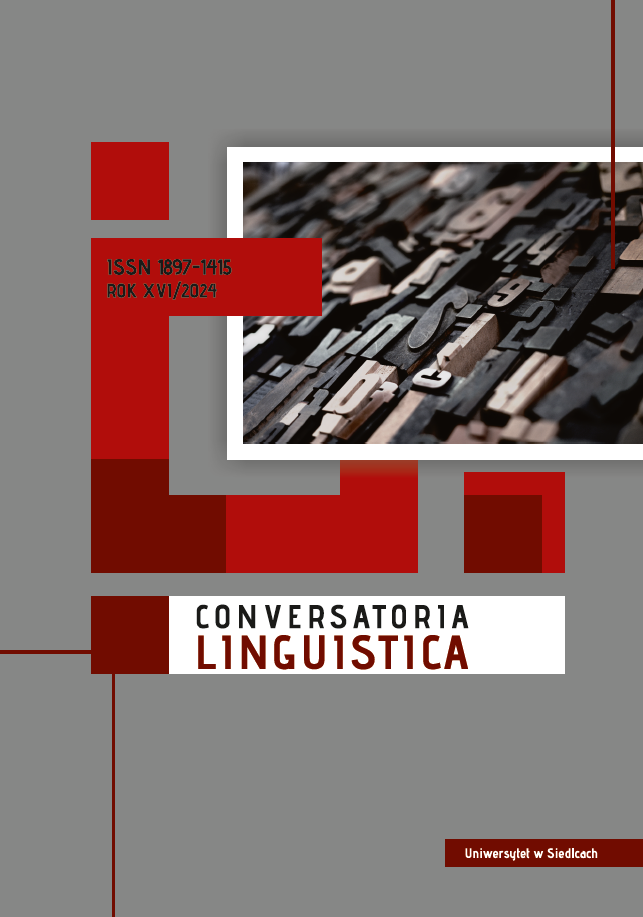The Latin verb vīdī and its cognates in Germanic and Slavic
DOI:
https://doi.org/10.34739/clg.2024.16.07Keywords:
Gr. oĩda, Lat. vīdī, Gmc. *witan, OCS vědě, Eng. wit, Pol. wiedziećAbstract
The article presents a brief historical account of the spread of Latin in Europe against the sociocultural background, including language contact. Latin left significant imprints on the cultural heritage of pre-, inter- and postmediaeval world, but it was not the only language associated with prestige, religion and education in older times. The article sketches the similarities, mutual relationships and contacts between Latin, Greek, Germanic and Slavic (attested in documents, the lexis and the writing systems of the latter daughter languages). In a microperspective, the present contribution focuses on the morphological and semantic peculiarities of the cognate verbs: Gr. oĩda, Lat. vīdī, Gmc. *witan (with special emphasis on Eng. wit, wot, wist, weet, etc.), and OCS vědě (with special emphasis on Pol. wiedzieć).
Downloads
References
Literature
Andersen H. (2021): On the formation of the Common Slavic koiné, in: New Perspectives on the Early Slavs and the Rise of Slavic: Contact and Migrations, Tomáš Klír, Vít Boček, Nicolas Jansens (eds.), Heidelberg, p. 11–42.
Barber C., Beal J.C., Shaw P.A. (2009): The English Language. A Historical Introduction (2nd ed.), Cambridge.
Bartula C. (2001): Podstawowe wiadomości z gramatyki staro-cerkiewno-słowiańskiej na tle porównawczym, Warszawa.
Beekes R.S.P. (2011): Comparative Indo-European Linguistics. An Introduction (2nd ed.), Amsterdam / Philadelphia.
Bennett W.H. (1980): An Introduction to the Gothic Language, New York.
Clackson J. (2007): Indo-European Linguistics: An Introduction, Cambridge Textbooks in Linguistics, Cambridge.
Darden B.J. (2018): Balto-Slavic morphology, in: J. Klein, B. Joseph, & M. Fritz (eds.), Hand-book of Comparative and Historical Indo-European Linguistics, Vol. 3, Berlin / Boston, p. 1985–2000.
Fulk R.D. (2018): A Comparative Grammar of the Early Germanic Languages, Studies in Germanic Linguistics, Vol. 3, Amsterdam / Philadelphia.
Hawes J. (2020): The Shortest History of England, Exeter.
Hogg R.M., Fulk R.D. (2011): A Grammar of Old English, Vol. 2, Morphology, Chichester.
Jackson H. (2002): Lexicography. An Introduction, London / New York.
Janson T. (2002): Speak. A short history of languages, Oxford.
Janson T. (2004): A Natural History of Latin (N. Vincent & M.D. Sørensen, Trans.), Oxford.
Klemensiewicz Z. (1976): Historia języka polskiego, Warszawa.
Krause T.B., & Slocum J. (2003): Old Church Slavonic Online (EIEOL-OCS). Linguistics Re-search Center, University of Texas at Austin, https://lrc.la.utexas.edu/eieol/ocsol, access date: 23.VI.2024.
Kuraszkiewicz W. (1972): Gramatyka historyczna języka polskiego, Warszawa.
Langston K. (2018): The documentation of Slavic, in: J. Klein, B. Joseph, & M. Fritz (eds.), Handbook of Comparative and Historical Indo-European Linguistics, Vol. 3, Berlin / Boston, p. 1397–1413.
Lehr-Spławiński T. & Bartula C. (1973): Zarys gramatyki języka staro-cerkiewno-słowiań-skiego, Wrocław.
Małecki A. (1863): Gramatyka języka polskiego. Większa, Lwów, https://po-lona.pl/preview/0dea085b-2e19-4cee-bc92-35e7a6afbf6a, access date: 23.VI.2024.
Oxford English Dictionary (OED), Oxford, https://www.oed.com/, access date: 23.06.2024.
Palmer L.R. (1954): The Latin Language, London.
Pokorny J. (1959): Indogermanisches etymologisches Wörterbuch, Vols. 1-3, Bern / München.
Ringe D.R. (2006): From Proto-Indo-European to Proto-Germanic. A Linguistic History of English, Vol. 1, Oxford.
Ringe D. & Taylor A. (2014): The Development of Old English. A Linguistic History of English, Vol. 2, Oxford.
Robinson O.W. (1992): Old English and its closest relatives. A survey of the earliest Germanic Languages, Stanford.
Sakhno S. (2018): The Lexicon of Slavic, in: J. Klein, B. Joseph, & M. Fritz (eds.), Handbook of Comparative and Historical Indo-European Linguistics, Vol. 3, Berlin / Boston, p. 1571– –1585.
Sanders R.H. (2010): German: Biography of a Language, Oxford.
Słownik pojęciowy języka staropolskiego (SPJS), Instytut Języka Polskiego Polskiej Akademii Nauk, https://spjs.ijp.pan.pl/, access date: 23.VI.2024.
Smyth H.W. (1920): A Greek Grammar for Colleges, Perseus Digital Library, the Department of Classical Studies, Tufts University, https://www.perseus.tufts.edu/hopper /text?doc=Smyth+grammar&fromdoc=Perseus%3Atext%3A1999.04.0007, access date: 23.VI.2024.
Tosi A. (2020): Language and the Grand Tour. Linguistic Experiences of Travelling in Early Modern Europe, Cambridge.
Downloads
Published
Issue
Section
License
Copyright (c) 2024 Conversatoria Linguistica

This work is licensed under a Creative Commons Attribution-NonCommercial 4.0 International License.




